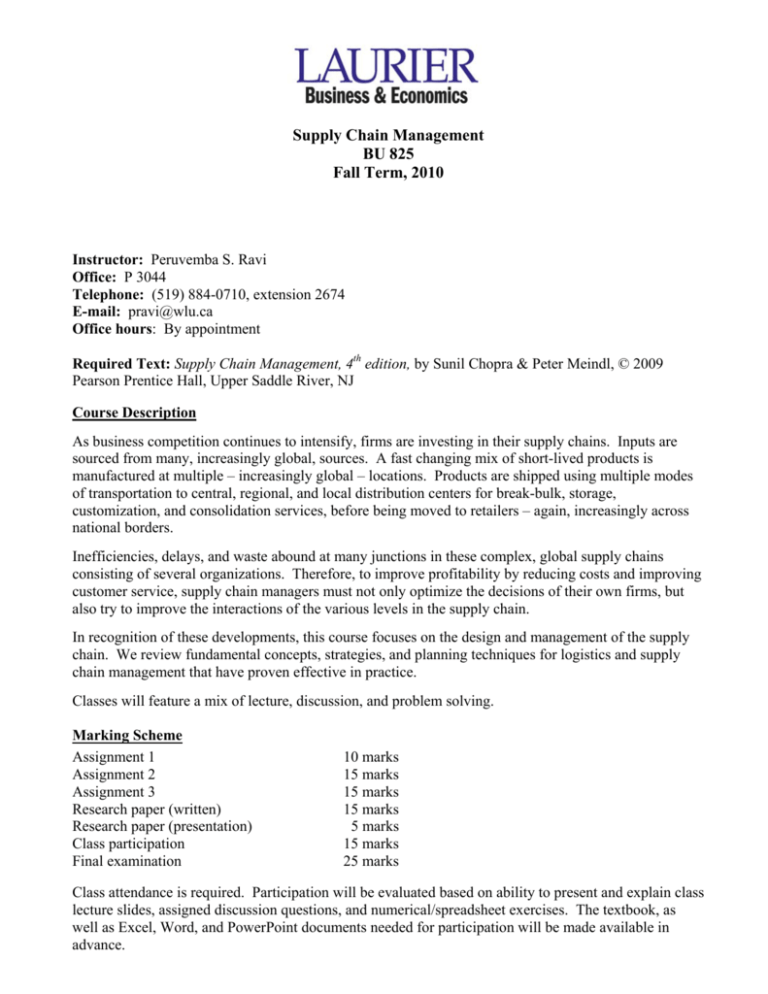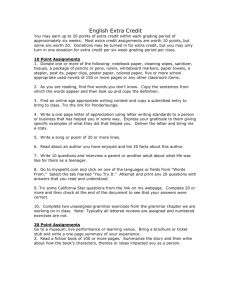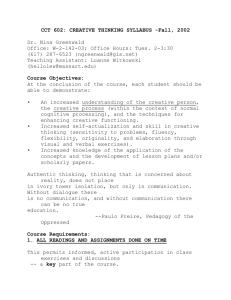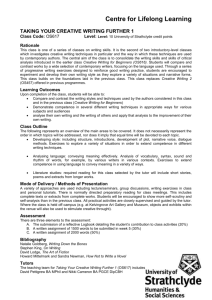
Supply Chain Management
BU 825
Fall Term, 2010
Instructor: Peruvemba S. Ravi
Office: P 3044
Telephone: (519) 884-0710, extension 2674
E-mail: pravi@wlu.ca
Office hours: By appointment
Required Text: Supply Chain Management, 4th edition, by Sunil Chopra & Peter Meindl, © 2009
Pearson Prentice Hall, Upper Saddle River, NJ
Course Description
As business competition continues to intensify, firms are investing in their supply chains. Inputs are
sourced from many, increasingly global, sources. A fast changing mix of short-lived products is
manufactured at multiple – increasingly global – locations. Products are shipped using multiple modes
of transportation to central, regional, and local distribution centers for break-bulk, storage,
customization, and consolidation services, before being moved to retailers – again, increasingly across
national borders.
Inefficiencies, delays, and waste abound at many junctions in these complex, global supply chains
consisting of several organizations. Therefore, to improve profitability by reducing costs and improving
customer service, supply chain managers must not only optimize the decisions of their own firms, but
also try to improve the interactions of the various levels in the supply chain.
In recognition of these developments, this course focuses on the design and management of the supply
chain. We review fundamental concepts, strategies, and planning techniques for logistics and supply
chain management that have proven effective in practice.
Classes will feature a mix of lecture, discussion, and problem solving.
Marking Scheme
Assignment 1
Assignment 2
Assignment 3
Research paper (written)
Research paper (presentation)
Class participation
Final examination
10 marks
15 marks
15 marks
15 marks
5 marks
15 marks
25 marks
Class attendance is required. Participation will be evaluated based on ability to present and explain class
lecture slides, assigned discussion questions, and numerical/spreadsheet exercises. The textbook, as
well as Excel, Word, and PowerPoint documents needed for participation will be made available in
advance.
Assignments: Assignments are due in class on the dates specified. Assignments must be submitted on
a data key (USB flash memory stick) to be supplied by each student. This data key is to be used
exclusively for assignments in this course. The instructor will not be responsible for loss of data
unrelated to this course on a student’s data key.
Assignment questions must be answered in a Microsoft Word document, and any Microsoft Excel
spreadsheets used in an assignment must also be submitted along with the Word document. The Word
document must be printed and stapled, and the Excel spreadsheet/s must be handed in on the data key
accompanying the printout. The student’s name and student ID must appear on both the Word
document and the data key.
Each assignment must be done individually, without collaboration.
Consultation will be available from the course instructor. A student may submit an advance electronic
copy of each assignment to me once before the assignment is due. I will provide prompt, detailed
feedback and hints if there are any errors in the analytic / spreadsheet work submitted.
Assignment 1
Network Design in the Supply Chain – Exercises 4 (parts a, b, c, and d) and 5 (parts a, b, and c)
Assignment 2
Planning Supply and Demand in a Supply Chain: Managing Predictable Variability – Mintendo Game
Girl Case Study (questions 1 and 2)
Managing Economies of Scale in a Supply Chain: Cycle Inventory – Delivery Strategy at MoonChem
Case Study (questions 1 and 2)
Assignment 3
Managing Uncertainty in a Supply Chain: Safety Inventory – Exercise 15
Determining the Optimal Level of Product Availability – Exercises 3 and 13
Sourcing Decisions in a Supply Chain – Exercise 1
Pricing and Revenue Management in a Supply Chain – Exercises 2 and 7
Research paper: Students will collaborate to research the following supply chain management topic:
multi-echelon production-inventory systems. At the end of the term, students will submit a (common)
report based on this work, and present their work in class as well.
This paper should state important methods and theorems/results, simply and clearly, together with short
numerical examples wherever feasible, but without mathematical proofs. All published sources must be
cited properly. The paper should also indicate which ideas potentially have practical value, where,
under what conditions, and what data and software will be needed for these applications.
The report must include a cover page, table of contents, and references section. It must be stapled, and
typed double-spaced, with 1-inch margins on all sides, in a font size large enough to read comfortably.
Report marks will be based on correct, clear, and well organized writing. Presentation marks will be
awarded for focusing on important ideas, and presenting them in a clear and interesting way.
The primary reading will be the INFORMS tutorial on this topic, provided electronically (as a pdf
document) to students. Other suggested resources for the research paper include readings provided to
students in electronic form, websites http://www.ascet.com and http://www.supplychainbrain.com, and
journals (such as Interfaces and Journal of Business Logistics) available electronically, in full text pdf
format, through the WLU library website.
Final examination: The examination will be closed book/closed notes, and require no calculations. It
will consist of true/false questions based on key ideas from assigned textbook readings and exercises.
2
CLASS SCHEDULE
Sept. 15
Topic: Understanding the Supply Chain
Reading: Chapter 1 [Discussion questions 2–5]
Topic: Supply Chain Performance: Achieving Strategic Fit and Scope
Reading: Chapter 2 [Discussion questions 1–4]
Sept. 22
Topic: Supply Chain Drivers and Metrics
Reading: Chapter 3 [Discussion questions 1–3, 5, 7]
Topic: Designing Distribution Networks and Applications to e-Business
Reading: Chapter 4 [Discussion questions 1–5, 7, 8, 11]
Sept. 29
Topic: Network Design in the Supply Chain
Reading: Chapter 5 [Discussion questions 2, 4, 6, 7; Exercises 1-3, 8]
Oct. 6
Topic: Aggregate Planning in a Supply Chain
Reading: Chapter 6 [Discussion questions 1, 2, 4, 7, 8; Exercises 4–7]
Topic: Planning Supply and Demand in a Supply Chain: Managing Predictable
Variability
Reading: Chapter 7 [Discussion questions 2–4, 6, 8, 9; Exercises 1–4]
Oct. 13, 20
Topic: Managing Economies of Scale in a Supply Chain: Cycle Inventory
Reading: Chapter 8 [Discussion questions 1–8; Exercises 1–6, 10, 11]
Oct. 20, 27
Topic: Managing Uncertainty in a Supply Chain: Safety Inventory
Reading: Chapter 9 [Discussion questions 1–4, 6, 8; Exercises 1–4, 6–8, 14]
Assignment 1 due on October 20
Oct. 27,
Nov. 3
Topic: Determining the Optimal Level of Product Availability
Reading: Chapter 10 [Discussion questions 1–3, 5; Exercises 1, 2, 6, 7, 11, 15]
Nov. 10
Topic: Transportation in a Supply Chain
Reading: Chapter 11 [Discussion questions 1–3, 6; Exercise 1]
Assignment 2 due on November 10
Nov. 17
Topic: Sourcing Decisions in a Supply Chain
Reading: Chapter 12 [Discussion questions 2–6; Exercises 2–5]
Nov. 24
Topic: Pricing and Revenue Management in a Supply Chain
Reading: Chapter 13 [Discussion questions 2, 5, 6; Exercises 3–6, 8, 9]
Dec. 1
Topic: Coordination in a Supply Chain
Reading: Chapter 14 [Discussion questions Discussion questions 1, 2, 4, 6, 7]
Research presentation (1 hour)
Dec. 8
In-class final examination (1 hour)
Assignment 3 due
Research report due by noon, December 14
3










